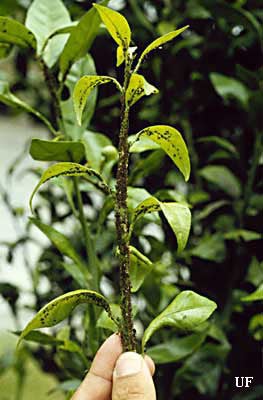Brown Citrus Aphid, Toxoptera citricida
The Situation: The brown citrus aphid (BrCA), is an insect pest of all citrus varieties. It is not a pest of non-citrus crops. The brown citrus aphid infests the stems and new leaves of citrus trees and in addition to feeding damage, it is a highly efficient vector of citrus tristeza virus (CTV). CTV can cause a range of symptoms in citrus trees from mild and barely noticeable to severe stem pitting and quick decline of trees, depending on the severity of the strain of CTV and the susceptibility of the rootstock and scion combination. When sour orange is used as a rootstock, trees suffer and then die from quick decline disease about 1-5 years after becoming infected CTV.
Damage: The brown citrus aphid damages citrus when heavy populations build up on young shoots, weakening trees and stunting growth. If it becomes established in California, BrCA will increase the severity of CTV transmission and disease pathogenicity that are currently found in California, but are not now effectively transmitted by the less efficient aphid vector, the cotton aphid (Aphis gossypii). Severe disease causing isolates of CTV began to appear in Florida approximately 10 years after BrCA was first detected in that state. In addition to increasing the severity of the disease, BrCA will also increase the rate at which the disease is spread from tree to tree. This is because BrCA can reproduce year round on stems of citrus and its lifecycle is closely associated with citrus. In contrast, the cotton aphid can only subsist on new flush of citrus and migrates to and from other crops such as cotton, pomegranate, melon, and weeds.
Economic Impact: California produces citrus primarily for the fresh market and the crop is valued at over $900 million/year. Oranges, on average, account for two-thirds of the State's citrus crop, lemons one-quarter, grapefruits 5%, and tangerines/clementines 5%, although the tangerine market is rapidly increasing. If BrCA becomes established in California, it will accelerate the spread of CTV in the Central Valley, where the present incidence of CTV is low (about 0.5 percent) and 80% of California citrus is grown. There is no cure for CTV and the only method of control is removal of CTV-infected trees. Growers in three of five pest control districts in the Central San Joaquin Valley provide support for a $1.7 million suppression program in which the Central California Tristeza Eradication Agency surveys citrus and removes CTV-infected trees. The consequences of the arrival of BrCA will be increased severity and rate of spread of CTV. The citrus nursery industry will need to be placed inside screenhouses to continue to produce disease free trees, growers will experience increased quick decline in sweet orange trees on sour orange rootstocks, reduction in the health, fruit size and production of many varieties of citrus, and greatly increased costs for the CTV suppression program.
Distribution: The brown citrus aphid originated in China and is now found throughout Africa, Asia, Australia, India, and South America. In recent years it has progressed through the Caribbean and Central America, and is found in the Yucatan region of Mexico. The pest was first reported in Florida at the end of 1995, where it is now well established. Brown citrus aphid is not yet found in California.
Research: Research is needed on BrCA, including the development of biological control agents, evaluation of pesticides for BrCA control, and landing deterrents or repellants to reduce aphid numbers and vectoring ability on citrus. Research focusing on the virus should include: (1) strain characterization of CTV and studies on the incidence and distribution of severe strains in California; (2) development of sensitive and specific CTV detection methods; (3) research on the rate of spread of the virus within groves; and (4) selection of citrus varieties with resistance to CTV.
Detection: Detection efforts should be focused on citrus plants. Brown citrus aphid species can be differentiated from other aphids infesting citrus based on body color (brown), it inhabits stems as well as leaves of citrus, and when squashed, it produces a reddish brown color.
More Media on the Brown Citrus Aphid
University of Flordia: Brown Citrus Aphid
University of Flordia: Brown Citrus Aphid Parasitoid
Invasive.org: Brown Citrus Aphid
Brown Citrus Aphid Images
Center for Invasive Species Research, University of California Riverside
Text provided by Elizabeth Grafton-Cardwell, Extension Specialist of Entomology
Photos courtesy of the University of Florida and UC ANR CS Media Library
Elizabeth Grafton-Cardwell, Extension Specialist of Entomology
elizabeth.grafton@ucr.edu
KAC Citrus Website
Media within CISR is licensed under a Creative Commons Attribution-NonCommercial-NoDerivs 3.0 Unported License. Permissions beyond this scope may be available at www.cisr.ucr.edu/media-usage.




